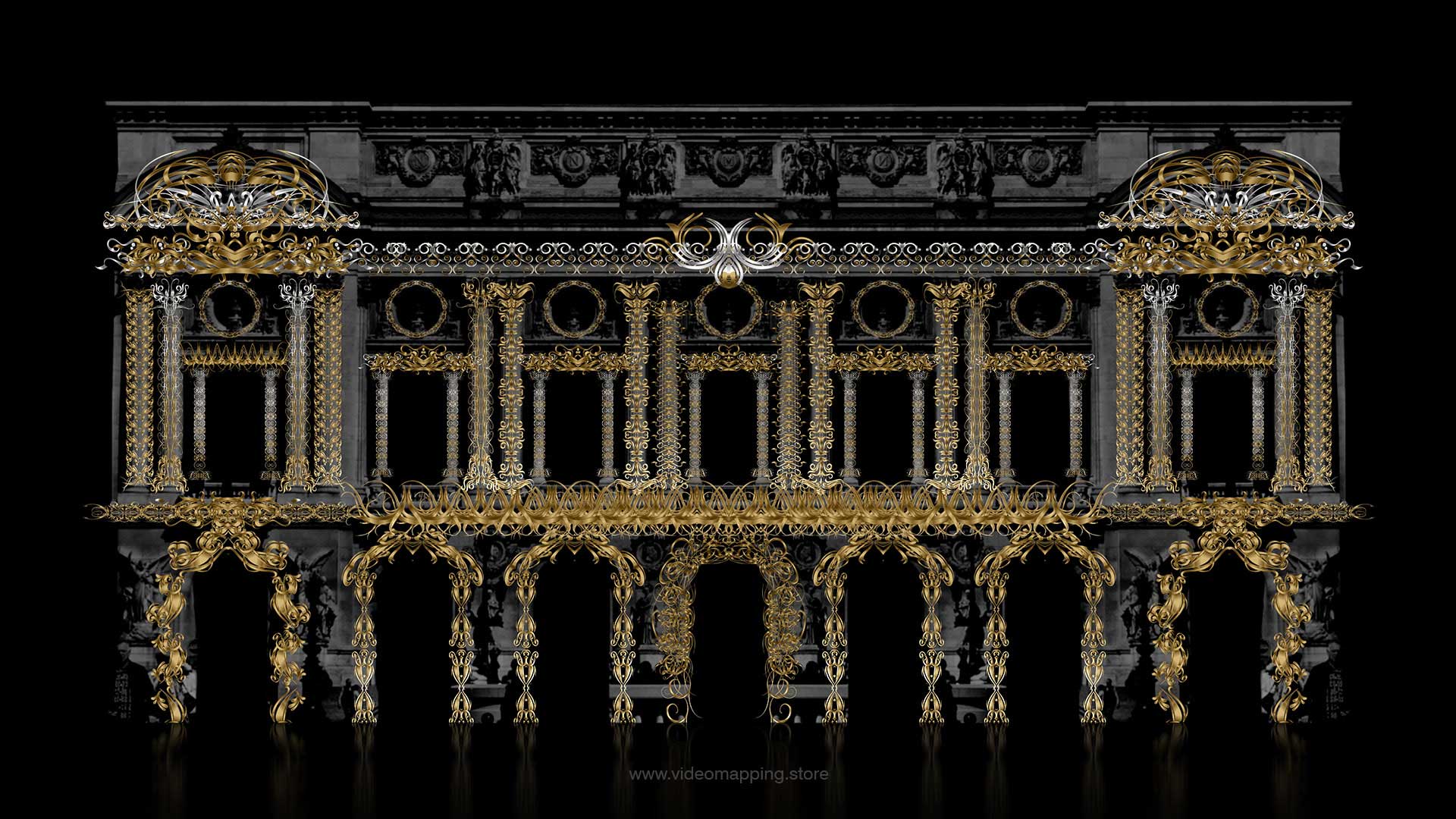Cultural heritage preservation is a critical endeavor that plays a vital role in maintaining the historical integrity of our world. It allows future generations to explore, learn, and appreciate the rich and diverse histories that have shaped societies. However, with the advent of technology, traditional preservation methods are being enhanced and transformed. Specifically, Projection Video Mapping has emerged as an innovative tool, breathing life into old structures and sites, making history more tangible and engaging. This article delves into the fascinating intersection of technology and heritage preservation, highlighting how projection video mapping is revolutionizing the way we experience and interact with historical sites. From understanding the basics of cultural heritage preservation to exploring its future prospects through video mapping, we invite you to journey with us through this exploration of past, present, and future.
1. “Understanding Cultural Heritage Preservation: An Overview”
Cultural heritage preservation is a critical endeavor that seeks to identify, protect, and maintain artifacts, buildings, landscapes, and traditions that have historical, cultural, or archaeological significance. This process is crucial as it helps to uphold the cultural identity of a society, while also providing educational insights into the past.
Cultural heritage can be tangible, including physical structures like historic buildings, monuments, artworks, books, and artifacts. It can also be intangible, including aspects such as folklore, traditions, language, and knowledge. Both tangible and intangible cultural heritage need active preservation efforts to ensure their survival for future generations.
Preservation of cultural heritage involves a wide range of activities, from restoration and conservation of historic buildings, to digitization of ancient texts, to recording and promoting traditional cultural practices. These activities are typically overseen by a variety of entities, including government bodies, heritage organizations, and local communities.
In recent years, technology has begun to play a significant role in cultural heritage preservation. One such technology is Projection Video Mapping, which can help in revitalizing historic sites, making them more engaging and appealing to the public. It can also serve as a non-invasive means to restore or enhance the appearance of these sites, preserving their integrity while making them accessible and interesting to modern audiences.
However, the preservation of cultural heritage is not without challenges. It often requires significant resources, both in terms of funding and expertise. There are also issues related to the ownership and control of cultural heritage, especially in cases where heritage has been displaced or appropriated. Despite these challenges, the preservation of cultural heritage remains a vital task, serving as a link between the past, present, and future, and contributing to a society’s sense of identity and continuity.
2. “The Rise of Projection Video Mapping in Heritage Preservation”
Projection Video Mapping, also known as spatial augmented reality, has emerged as a powerful tool in the field of heritage preservation. Its rise can be attributed to its unique ability to create immersive, interactive experiences that bring historical sites to life, while simultaneously preserving their physical integrity.
The technology uses advanced imaging and projection techniques to map light onto any surface, turning common objects or even whole buildings into interactive displays. With the help of 3D software, it can generate an illusion of depth and movement on static structures, providing an unparalleled visual experience. Projection mapping has been used in a variety of settings, from music concerts to advertising campaigns, but its use in heritage preservation is a relatively new, yet rapidly growing field.
The rise of projection video mapping in heritage preservation began when professionals in the field started to explore innovative ways to make historical sites more appealing and engaging to the public. Traditional methods, such as static displays and guided tours, were not sufficient in capturing the attention and interest of younger generations. They were in need of a tool that could narrate the past in a more dynamic and interactive way.
Additionally, many historical sites face the challenge of aging and deterioration. Physical restoration can be costly, time-consuming, and in some cases, may even damage the original structure. Projection video mapping offers a non-invasive solution to this issue. By projecting images onto the surface, it can visually ‘restore’ the site without physically altering it.
As digital technology continues to evolve, so does the quality and realism of projection video mapping. It is now possible to create highly detailed, lifelike animations that can transport viewers back in time, allowing them to witness historical events or see what the site looked like in its prime.
Today, projection video mapping is being used in heritage preservation projects around the world. It’s not just a tool for entertainment, but also a means of education, creating a unique platform for storytelling, and fostering a deeper appreciation for cultural heritage. The rise of projection video mapping marks a new era in heritage preservation, one that embraces the power of technology to keep history alive for future generations.
3. “Case Studies: How Video Mapping Revitalizes Historic Sites”
Projection video mapping is a unique tool that can help in the revitalization of historical sites. This technology provides a dynamic and engaging method to present the significance and stories of these sites to the public. Here are three exemplary case studies that illustrate how video mapping has been utilized to breathe new life into historic sites.
Firstly, let’s look at the “Lumina” light festival that took place in Cascais, Portugal. This festival utilized video mapping to transform the façade of the Cascais Citadel into a vibrant, interactive canvas. The installation was used to narrate the history of the citadel, using a combination of illumination, sound, and animation. This not only attracted a larger crowd but also increased the public’s understanding and appreciation of the citadel’s historical significance.
Secondly, the “GLOW” festival in Eindhoven, the Netherlands, is a prime example of how video mapping can revitalize industrial heritage. The event, held annually, features numerous light art installations throughout the city, including projection mapping displays on iconic buildings. One particularly memorable display was on the former Philips factory, where a video mapping presentation told the story of Eindhoven’s industrial past and the role Philips played in its development.
Lastly, the “Lichtfestival” in Ghent, Belgium, stands as another excellent example. The Belfry, a UNESCO World Heritage site, was the canvas for a video mapping installation that recounted the city’s history through stunning visuals and sound effects. This offered a fresh and engaging way to showcase the city’s rich heritage, attracting both locals and tourists.
These case studies exemplify how video mapping can revitalize historic sites by not only attracting more visitors but also enhancing their understanding and appreciation of a site’s historical significance. Thus, projection video mapping plays a crucial role in cultural heritage preservation by providing a modern, innovative method of interpreting and presenting history.
4. “The Role of Technology in Conserving Cultural Heritage”
Technology plays a pivotal role in the conservation and preservation of cultural heritage. It not only helps document, analyze, and preserve important aspects of our shared history, but also brings it to life in a way that excites and engages contemporary audiences. One such technological innovation is Projection Video Mapping, a tool that has been progressively harnessed to revitalize historic sites.
Projection Video Mapping, or simply video mapping, is a technology that turns objects, often irregularly shaped, into a display surface for video projection. This technology can create stunning visual effects on physical surfaces such as buildings, enhancing their architectural details and transforming them into dynamic pieces of art.
In the context of cultural heritage preservation, this technology can be used to vividly represent historical events, customs, and traditions. It can recreate lost elements of a site, or simulate potential threats to it, such as the effects of climate change or urbanization. This can help stakeholders better understand the importance of conservation efforts and the urgency of the challenges faced.
Moreover, video mapping can be used for digital archiving and rehabilitation of heritage sites. High-resolution digital scanning can capture minute details of a structure, allowing for a level of documentation that was not previously possible. This data can be used to create precise 3D models which can serve as a critical resource in restoration projects, and in cases where the physical site is damaged or destroyed, these models can help preserve its memory.
Finally, through its potential to create engaging, immersive experiences, video mapping can play a key role in cultural tourism. By attracting visitors, it can generate revenue that can be reinvested into preservation efforts, ensuring that these historic sites are maintained for future generations.
In summary, technology, and in particular projection video mapping, can be a powerful ally in the fight to conserve our cultural heritage. It offers innovative ways to document, preserve, and showcase historic sites, making the past a vibrant part of the present, and ensuring its place in the future.
The Potential and Challenges of Using Video Mapping in Heritage Sites
The utilization of video projection mapping in heritage sites holds immense potential but also presents a set of unique challenges.
The potential of video mapping lies in its ability to transform the viewing experience of historic locations. By projecting videos and graphics onto these sites, their story can be told in a captivating and dynamic way. This digital re-interpretation of historical narratives can make these sites more appealing to contemporary audiences, potentially increasing visitor numbers and public interest. In essence, video mapping can provide a new perspective on our cultural heritage, helping people to see the past in a new light.
Furthermore, video mapping can also be used as a tool for conservation. By creating a digital replica of the site, it is possible to monitor and record changes to the physical structure over time. This could be crucial in identifying areas of the site that are in need of restoration or preservation.
Despite these potential benefits, there are also significant challenges to consider. One of the main issues is ensuring that the use of video mapping respects and preserves the integrity of the heritage site. There is a risk that the projection could cause physical damage to the site, or that the visual effects might detract from the original features of the site.
Moreover, creating a projection that accurately represents the history and significance of the site can be complex. This process requires a deep understanding of the site’s cultural and historical context, as well as advanced technical skills in video mapping.
Another challenge is the cost. Setting up a video mapping display can be expensive, and maintaining it over time can also require significant resources. This could pose a financial challenge for many heritage sites, especially those that are run by non-profit organizations or rely heavily on public funding.
Overall, while video mapping offers a promising solution to the challenge of revitalizing heritage sites, its implementation requires careful consideration. It is crucial to balance the desire for innovation with the need to respect and preserve our cultural heritage.
Projection Video Mapping: A Tool for Interactive Learning and Engagement
Projection video mapping has emerged as a powerful tool in promoting interactive learning and engagement at historic sites. This innovative technology is not only enhancing the aesthetic appeal of these sites but also transforming the way visitors experience history and culture.
Traditional methods of conveying information, such as guided tours and information placards, often fall short in fully engaging visitors. However, projection video mapping, with its immersive visual storytelling, offers a more dynamic and captivating mode of learning. It uses the architecture of the historic site as a canvas to display digital artworks or to reconstruct historical events, thereby offering an engaging way to bring history to life.
The technology uses advanced software to manipulate or ‘map’ video content onto the surfaces of buildings or objects, often in three dimensions. This creates an interactive and immersive environment that can educate visitors about the historical significance, cultural relevance and architectural value of the site. The multimedia content can be tailored to provide a wide range of information, from historical timelines to cultural narratives, enhancing understanding and appreciation of the site’s heritage.
Moreover, projection video mapping can stimulate engagement, prompting visitors to interact with the content. By integrating interactive elements, such as sensor-based triggers or augmented reality interfaces, visitors can directly influence the visual display, creating a more personalized and immersive experience. This form of active participation can enhance learning outcomes, as visitors are more likely to remember information they interacted with.
The power of projection video mapping as a tool for interactive learning and engagement is evident in its growing use in cultural heritage preservation. From illuminating the ancient ruins of Rome to revitalizing the historic facades of Old Montreal, this technology is breathing new life into historic sites around the world.
In summary, projection video mapping is more than just a technological novelty. It is a potent educational tool that enhances visitor engagement, enriches learning experiences, and fosters a deeper appreciation of our cultural heritage. As such, it is set to play an increasingly important role in the preservation and revitalization of historic sites.
Future Prospects: The Evolution of Heritage Preservation through Video Mapping
The future of heritage preservation through video mapping looks promising with the constant advancement in technology. As projection video mapping continues to evolve, it is expected to play a more significant role in enhancing the value of cultural heritage sites and making them more interactive and engaging for visitors.
In the near future, we can anticipate more immersive experiences with the integration of Virtual Reality (VR) and Augmented Reality (AR) in video mapping. This technology could allow visitors to virtually step back in time and experience the historic site as it was in its prime. It could also provide real-time information about the site, enhancing the educational value of the visit.
Moreover, the introduction of AI and machine learning can further revolutionize the way video mapping is used in heritage preservation. Through machine learning algorithms, the system could potentially analyze visitor interactions and reactions to the projection video mapping and adjust the content accordingly, enhancing the overall visitor experience.
The use of drones for video mapping is another prospective development. Drones can capture detailed images of the site from various angles, which can then be used for creating more accurate and comprehensive 3D models of the site. This can help in better understanding the structure and planning the preservation work more effectively.
Another interesting prospect is the integration of holography with video mapping, where 3D holographic projections could be used to restore the missing parts of the heritage sites, providing a complete picture of the historic structure.
The evolution of heritage preservation through video mapping is not only about technology; it is also about community participation. The future of this field could see more collaborative projects where local communities are involved in the creation of the video content. This approach can help in preserving and promoting local culture and history.
In conclusion, the future of heritage preservation through video mapping is rich with possibilities. From immersive experiences to community participation, the evolution of this field is set to revolutionize the way we perceive and interact with historic sites, ensuring their preservation for future generations.
Projection video mapping has revolutionized the field of cultural heritage preservation, transforming historic sites into dynamic, interactive learning environments. This technology has not only breathed new life into historic sites, but has also opened up new avenues for education and engagement, helping to ensure that our cultural heritage is not only preserved, but also appreciated and understood by future generations. However, as with any new technology, there are challenges that need to be addressed to fully harness its potential, including technical difficulties and the need for specialized skills. As we look to the future, it is clear that video mapping will continue to evolve and play a crucial role in the preservation and celebration of our shared cultural heritage.



